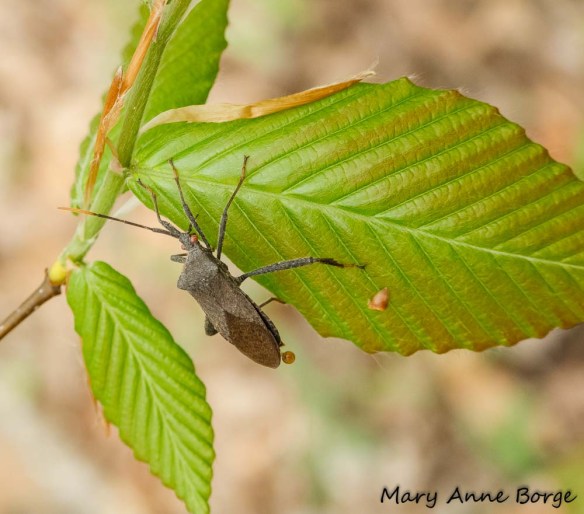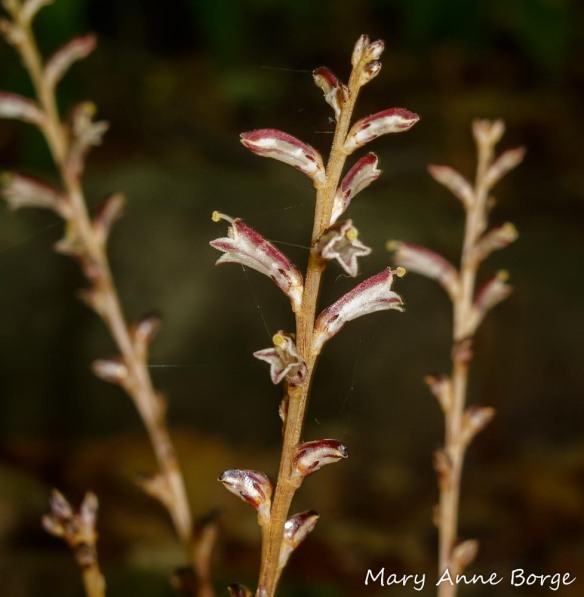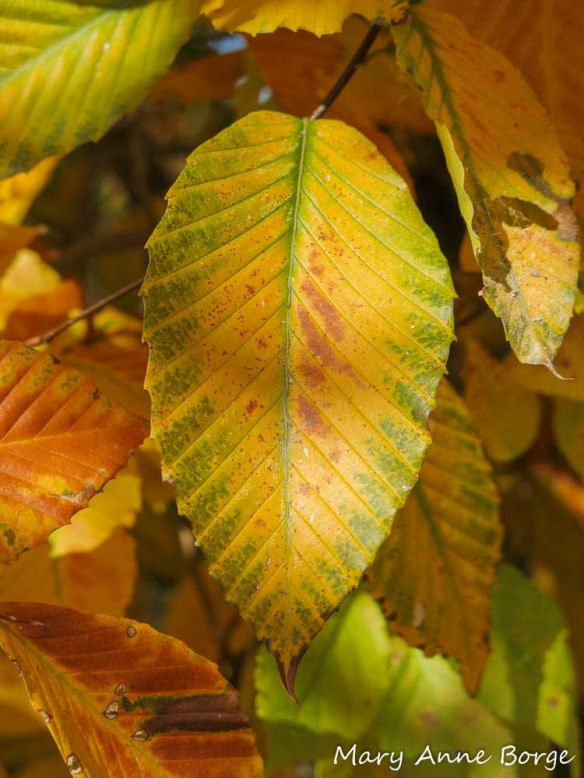It can be surprising to see leaves clinging to deciduous trees in mid-winter. In eastern North America, some oak species and American Hophornbeam (Ostrya virginiana) may retain their leaves but American Beech (Fagus grandifolia) trees are among the most conspicuous to do so. By January its leaves are bleached to a papery pale tan, catching the bright winter light while fluttering in the winter wind. The leaves look delicate, but give one a tug and you’ll see how tenaciously they adhere to their branches. American Beech leaves typically stay on the trees until early spring, withstanding the effects of even ice and snow.
Why do American Beech and other trees keep some of their leaves in winter? There are many theories: the dry leaves may be a deterrent to winter browsing by deer, moose and other mammals; holding some of the leaves until spring may be the trees’ way of time-releasing some nutrients for recycling into the soil; the leaves may funnel more snow melt to the tree’s root system. But no one knows for certain what caused this trait.
The smooth, pale gray bark is an unmistakable characteristic of American Beech, often tempting passers-by to carve their initials. A more interesting possibility is a sighting of animal ‘tracks’ – claw marks from animals that may have climbed the tree at some point.
Trees are susceptible to frost cracks in winter, caused by warming from the low-angled rays of the winter sun, followed by rapid cooling when the sun sets or disappears behind a cloud. Both the bark and the wood it encompasses expand in the warm sun, but the bark may cool more quickly than the wood when the sun disappears, causing lengthwise cracks to occur in the bark. If temperatures are warm enough, portions of the inner bark may become active, only to be killed if a rapid refreeze occurs. American Beech evolved to minimize the harsh effects of the sun by having light-colored bark that reflects the sun’s rays. The winter leaves may provide an additional layer of protection from the warm sunlight.
American Beech’s long, sharply pointed copper-colored buds are another distinctive winter identification feature.
As spring approaches, American Beech buds grow longer and plump, eventually opening to reveal newly unfurling leaves, accordion pleated and hairy as they first emerge. The long silky hairs are an adaptation to make the new leaves less appealing to the many species of hungry caterpillars and other insects that may eat the leaves later as the hairiness dissipates.
According to Bringing Nature Home by Douglas Tallamy, American Beech provides food for the caterpillars of over 100 species of butterflies and moths. Among them is the Early Hairstreak butterfly, a rare species found in deciduous or mixed woodlands from the maritime provinces of Canada to northern Michigan and Wisconsin through the Appalachians to Tennessee and North Carolina. Early Hairstreak caterpillars can only eat the leaves of American Beech and Beaked Hazelnut (Corylus cornuta). The presence of caterpillars attracts predatory insects and arachnids to feed on them, including many species of spiders, wasps, ants and flies. These insects are beneficial to the trees, because they help keep the caterpillar population in check.
In addition to butterfly and moth caterpillars, a few of the insects that use American Beech include Leaf-footed Bugs,
leaf-rollers,
and Woolly Beech Aphids.
The Woolly Beech Aphids’ honeydew in turn attracts other insects who eat it, including wasps and ants.
Ants help protect the tree from the insects that feed on its leaves, by aggressively attacking them.
The Harvester butterfly also feeds on the Woolly Beech Aphid’s honeydew, although its first choice is Wooly Alder aphids. The Harvester’s caterpillars eat the aphids themselves.
A non-native scale insect (cryptococcus fagisuga) introduced through the nursery trade on European Beech threatens the health of American Beech by providing an opening in the bark that together with a fungus enables beech bark disease. This is a good example of the importance of using native plants in your own garden, and the danger of using introduced exotic plants.
There is a fungus species that grows exclusively on the Woolly Beech Aphid’s honeydew, a sooty mold descriptively named Beech Aphid Poop-eater (Scorias spongiosa). Some studies have shown that leaves covered in sooty molds are more effective at removing pollution from the air than other leaves are.
Oyster (Pleurotus ostreatus) and Burnt-Orange Bolete (Tylopilus ballouii) mushrooms, both edible, are among the other fungi that may be found on or near American Beech.
American Beech develops natural cavities that provide nesting sites for cavity nesting birds like Titmice, Chickadees, Woodpeckers and Nuthatches, all of whom rely on insects for a large part of their diet, and will help protect the tree from insect leaf-eaters. Chipmunks, squirrels, porcupines and other mammals also take advantage of the natural shelter American Beech offers.
Other birds, like the Wood Thrush below, may nest on the limbs of American Beech, using some of the previous year’s fallen leaves as nesting material.

Wood Thrush on her nest in an American Beech. Some old Beech leaves have been used as nest material.
American Beech’s fallen leaves may offer insect protein for ground-feeders like the Ovenbird.
Beechdrops (Epifagus virginiana) depends on American Beech for its survival, since it gets its food from the tree’s roots. Look for the flowers in late summer or early fall, and the brown seed capsules throughout the winter.
American Beech flowers are wind pollinated, with separate male and female flowers both on the same plant. They bloom as the leaves are opening.
Nuts are produced if the flowers are successfully pollinated, usually 2 or 3 three-sided nuts per husk.
The nuts are a source of high protein and fat for mammals and birds, including red, gray and flying squirrels, chipmunks, bears, Blue Jays, Tufted Titmice, Wild Turkey, and Ruffed and Spruce Grouse.
Nothing goes to waste in nature, so an empty beechnut husk may be reused as a shelter by an insect.
As the nights get longer and the temperatures drop in the fall, the American Beech begins to prepare for winter. The leaves gradually stop producing chlorophyll, which reduces the green color visible in the leaves, revealing the yellows and oranges of carotenes, and the brown tannins, .
American Beech is native in moist woodlands in the eastern United States and Canada. The bounty of insects supported along with its nutritious nuts makes it one of our most valuable tree species for wildlife.
Resources
Cech, Rick; Tudor, Guy. Butterflies of the East Coast. 2005.
Eastman, John. The Book of Forest and Thicket. 1992.
Eaton, Eric R.; Kauffman, Ken. Kaufman Field Guide to Insects of North America. 2007.
Lincoff, Gary H. National Audubon Society Field Guide to North American Mushrooms. 1981
Rhoads, Ann Fowler; Block, Timothy A. The Plants of Pennsylvania. 2007
Tallamy, Douglas W. Bringing Nature Home, 2007,
Wojtech, Michael. Bark A Field Guide to Trees of the Northeast. 2011.
iNaturalist.org
http://www.inaturalist.org/taxa/144013-Scorias-spongiosa
Butterflies and Moths of North America http://www.butterfliesandmoths.org/species/Erora-laeta
Illinois Wildflowers
http://www.illinoiswildflowers.info/trees/plants/am_beech.htm
Penn State Extension Natural Resources
http://extension.psu.edu/natural-resources/forests/news/2012/winter-leaves-that-hang-on
Northern Woodlands
http://northernwoodlands.org/articles/article/why-do-some-leaves-persist-on-beech-and-oak-trees-well-into-winter
Invasive.org
http://www.invasive.org/browse/subinfo.cfm?sub=300























Pingback: LIFE's a Beech - Bob's Two Cents
I love your wording and your pictures, I’m doing a school project on ecosystems (i chose the Temperate forest) and this is helping me A LOT 🙂
(by A LOT 1 mean I got the MAJORITY of my American beech tree information
I’m glad it was helpful! Good luck with your project.
Your knowledge and photographic eye are amazing and compelling. Thanks so much for this essay and the photos.
Thank you, Jim!
We have some very large beech trees in our yard here in Kentucky. I have wanted to plant a fern/hosta/impatien/coleus bed underneath the one around which our driveway circles. Would this be harmful to the beech? Especially if I add some soil (4-6 inches or so) inside a stone border? If soil can be added, how far away from the trunk would I need to stop the soil?
It’s usually best not to cover up roots, but rather let them do their own thing. You might try adding some native perennials. You can get suggestions from the National Audubon Society here: https://www.audubon.org/native-plants
Pingback: Pondering Water Cycles on the Northwest Branch Trail - Eye On Sligo Creek
Pingback: A Tree Reincarnated | The Natural Web
Pingback: Michigan Tree Diversity Matters – Lakeshore Land and Tree People
Pingback: Oaks Have a Lot of Gall! | The Natural Web
Beech was one of the primary foods for the now extinct Passenger Pigeon. Clearing of the beech and oak forests was one of the reasons for its extinction.
Humans can be a pretty destructive species. It makes it all the more important that we do what we can to preserve natural areas, and enhance our own properties, no matter how big or small, with native plants.
humans are like aliens invading different ecosystems, changing stuff so much that animals cant adapt to it quickly leading them to start to die, its sad how we can do that to a species
You’re right, Madison. We as individuals and as a species need to be much more aware of the effect of our actions, and much more respectful of the other species with which we share the planet. Every other species has as much right to be here a we do, and we all depend on each other. We each have to take personal responsibility for behaving respectfully towards all other species, and we need to try to influence others, including our elected officials, to do the same.
Pingback: Crayon-colored Hickories | The Natural Web
This is very informative and a big help as I have chosen the American Beech for a special “native tree project” as part of a botanical illustration course I’m taking. In researching this tree, I have not had any luck identifying significant differences between the European Beech and American Beech. Perhaps you can help.
Hi Lynne,
‘The Sibley Guide to Trees’ by David Allen Sibley gives a good description of the differences between the two species, and includes drawings. One of the differences easiest to see is that the leaves of the European Beech (Fagus sylvatica) are wider, and have an untoothed, wavy margin. American Beech (Fagus grandifolia) leaves have distinctly toothed leaves. It’s a good reference if you can get a copy. The Missouri Botanical Garden website has good info, too:
European Beech: http://www.missouribotanicalgarden.org/PlantFinder/PlantFinderDetails.aspx?kempercode=a866
American Beech: http://www.missouribotanicalgarden.org/PlantFinder/PlantFinderDetails.aspx?kempercode=a865
Hope that helps!
Mary Anne
Thank you for this bounty of information accompanied by your gorgeous photos
Thanks, Monica! I’m glad you enjoyed it.
Reading this makes me appreciate our 2 large ~100 year old beech trees in our yard even more. I haven’t found any beech drops near them, but found some in our neighbor’s yard- maybe the roots are over there too?! Can’t wait to share this with Eli- he wants to see pictures of Beech Aphid poop-eaters. Thanks! Jess
Hi Jess,
The roots could indeed be in your neighbor’s yard. And you can take Eli to see the real thing at BHWP!
Wonderful American Beech article , Thank you. The name of the process whereby some plants hang on to certain organs such as leaves, as with the American Beech, is called marcescence. Best, Michael W. O’Brien Valley Head, AL
Sent from my iPhone 5s
>
Thanks for your contribution!
I am not sure which is more compelling–your clear, concise information or your amazing photos!
Thanks, Jean!
Very informative with wonderful identifying photos.
Thank you!
Reblogged this on Rex The Reclaim Bear.
Found this from the comment you left at my team site Beautiful Wildlife Garden. Fabulous photos! And excellent coverage of the value of beech to wildlife. Thank you 🙂
Thanks, Carole! I really enjoy the team’s work at Beautiful Wildlife Garden.
Great article!! Thank you!
Thanks, Deedee!
Thank you. Rich text matched with compelling images.
Thank you!